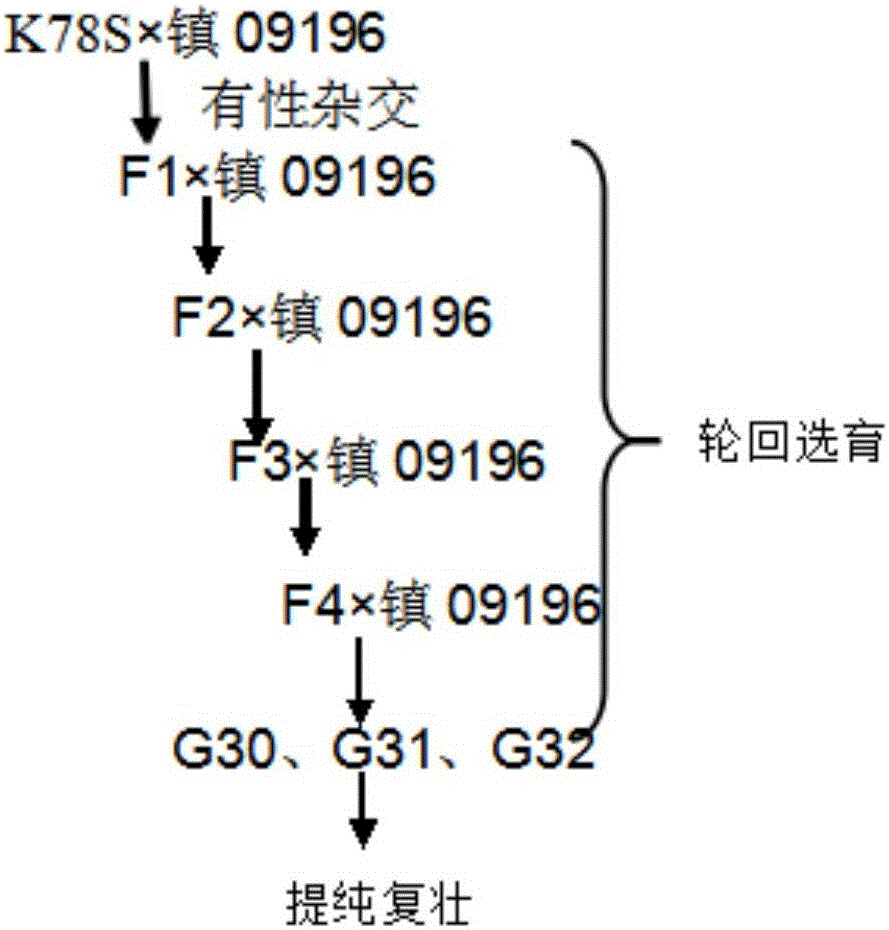Wheat temperature-light-sensitive sterile line trans-breeding method
A temperature-sensitive type, wheat technology, applied in the field of breeding, can solve the problem of shortening the time process of the breeding cycle of grain materials, and achieve the effect of reducing the time of homozygosity and shortening the breeding period
- Summary
- Abstract
- Description
- Claims
- Application Information
AI Technical Summary
Problems solved by technology
Method used
Image
Examples
Embodiment 1
[0028] A kind of wheat temperature and photosensitive male sterile line transfer method (such as figure 1 ), including the following steps:
[0029] The sterile line parent material K78S was used as the female parent, and Zhen 09196 was used as the male parent. The two were sexually crossed, and Zhen 09196 was used as the recurrent parent for 5 rounds of recurrent breeding;
[0030] (1) Carry out sowing date identification on the F5 generation, carry out sowing date test every 5 days from October 20th to December 20th, plant panicle rows, row length 1.5m, row spacing 8 inches, bagging at flowering stage, according to Anther silking and glume opening degree and microscopic examination and grain firmness of harvest investigation, screening of sterile lines, determination of sterility interval and recovery interval of new materials;
[0031] (2) Strictly screen and select two-line materials of CMS lines G30, G31, and G32 with red skin, dwarf stalk, and strong head blight resista...
Embodiment 2
[0036] A method for breeding a temperature-sensitive sterile line of wheat, comprising the steps of:
[0037] (1) The sterile line parent material K78S was used as the female parent, Zhen09196 was used as the male parent, the two were sexually crossed, and Zhen09196 was used as the recurrent parent for 5 rounds of breeding;
[0038] (2) Strictly screened and bred two lines of CMS lines G30, G31 and G32 with red skin, dwarf stalk and strong head blight resistance;
[0039] (3) Tissue culture the two-line material of the sterile line separated by identification, specifically:
[0040] Pre-soak the young wheat embryos that have been grouting for 12 days in water for 24 hours, and disinfect them with 1% hypochlorous acid solution for 10 minutes. After disinfection, the grains are rinsed three times with distilled water under aseptic conditions, and placed in a petri dish containing medium. Place the petri dish indoors at a temperature of 20-22°C without any additional lighting. A...
PUM
 Login to View More
Login to View More Abstract
Description
Claims
Application Information
 Login to View More
Login to View More - R&D
- Intellectual Property
- Life Sciences
- Materials
- Tech Scout
- Unparalleled Data Quality
- Higher Quality Content
- 60% Fewer Hallucinations
Browse by: Latest US Patents, China's latest patents, Technical Efficacy Thesaurus, Application Domain, Technology Topic, Popular Technical Reports.
© 2025 PatSnap. All rights reserved.Legal|Privacy policy|Modern Slavery Act Transparency Statement|Sitemap|About US| Contact US: help@patsnap.com


